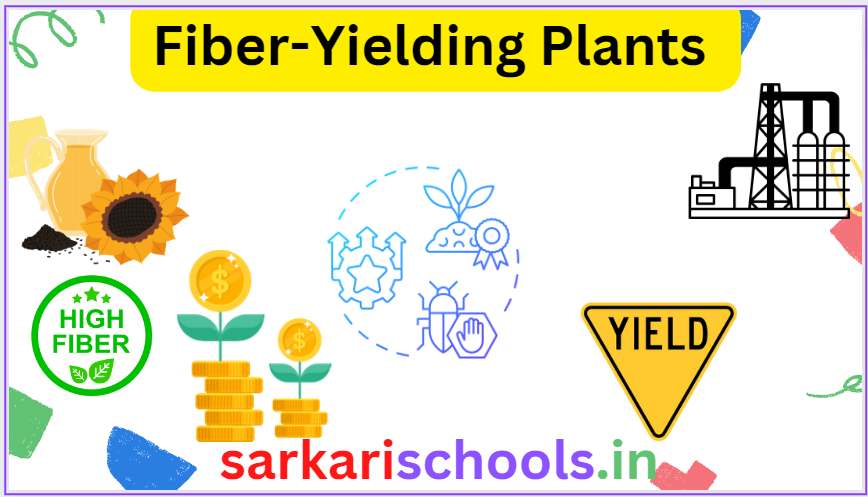Explore the world of Fiber Yielding Plants with our comprehensive guide. From the versatile cotton to the eco-friendly hemp and resilient jute, discover the significance, cultivation, and diverse applications of these plants. Unravel the threads that connect agriculture, industry, and sustainability in this exploration of nature’s fabric.

The Rich Tapestry of Fiber Yielding Plants: Nature’s Fabric in Agriculture
Introduction:
Fiber-yielding plants have been an integral part of human civilization, providing the raw materials for textiles, ropes, and a myriad of other products. In this article, we will explore the diverse world of plants that yield fibers, focusing on their significance, cultivation, and the broad range of applications that contribute to various industries.
- Cotton (Gossypium spp.): Cotton, often referred to as “white gold,” stands as one of the most widely cultivated fiber-yielding plants globally. Known for its softness, breathability, and versatility, cotton fibers are extensively used in the textile industry. Cotton cultivation plays a vital role in the agricultural landscapes of regions with suitable climates, including parts of India, the United States, and China.
- Jute (Corchorus spp.): Jute, often dubbed as the “golden fiber,” is primarily grown in the Indian subcontinent, particularly in the Ganges Delta region. The long, shiny fibers extracted from jute plants are renowned for their strength and are commonly used for making sacks, bags, and twine. Jute cultivation contributes significantly to the economy of regions like Bangladesh and West Bengal.
- Flax (Linum usitatissimum): Flax, both for its seeds and fibers, has been cultivated for centuries. The strong, durable fibers from flax plants are used in the production of linen. Beyond textiles, flax fibers find applications in paper and composite materials. The cultivation of flax is notable for its adaptability to diverse climates.
- Hemp (Cannabis sativa): Hemp fibers, derived from the stalks of the hemp plant, are known for their strength and durability. Historically used for making ropes and sails, hemp fibers are now gaining popularity in eco-friendly textiles. Hemp cultivation is prized for its sustainability, as the plant requires minimal pesticides and grows rapidly.
- Ramie (Boehmeria nivea): Ramie, native to eastern Asia, produces one of the strongest natural fibers. Resistant to bacteria, mildew, and insects, ramie fibers are used in high-quality textiles. Despite its toughness, ramie fabric remains breathable, making it a valuable alternative in the textile industry.
Applications and Economic Impact:
Fiber-yielding plants play a crucial role in various industries, from fashion to construction. The textile industry heavily relies on cotton, jute, flax, hemp, and ramie for producing fabrics with different textures and properties. Additionally, these plants contribute to the manufacturing of ropes, twines, paper, and even eco-friendly building materials.
In terms of economic impact, the cultivation and processing of fiber-yielding plants support the livelihoods of millions of people worldwide. The demand for sustainable and natural fibers in the global market further underscores the economic importance of these crops.
Conclusion:
The world of fiber-yielding plants is a diverse and fascinating one, weaving together threads that connect agriculture, industry, and everyday life. From the softness of cotton to the strength of jute and hemp, these plants continue to shape the fabrics of our existence, providing both economic sustenance and ecological benefits. As sustainable practices gain prominence, the cultivation of fiber-yielding plants stands at the forefront of a more environmentally conscious and economically viable future.
Q1: What are fiber-yielding plants?
A1: Fiber-yielding plants are plants that produce natural fibers used in various industries, such as textiles, ropes, paper, and construction materials. Examples include cotton, jute, flax, hemp, and ramie.
Q2: Why is cotton referred to as “white gold”?
A2: Cotton is called “white gold” due to its economic importance in the textile industry. Its softness, breathability, and versatility make it a valuable and widely used material in the production of textiles.
Q3: What is the significance of jute as the “golden fiber”?
A3: Jute is known as the “golden fiber” because of its golden-brown color and economic significance. The strong fibers extracted from jute plants are used in making sacks, bags, and twine, contributing significantly to the economy of regions where it is cultivated.
Q4: How is flax utilized in addition to its fibers?
A4: Flax is cultivated for both its seeds and fibers. The fibers are used in the production of linen, while the seeds are used for extracting flaxseed oil. Flax fibers also find applications in paper and composite materials.
Q5: What makes hemp fibers eco-friendly?
A5: Hemp fibers are considered eco-friendly because hemp plants require minimal pesticides, grow rapidly, and have various uses. Hemp fibers are strong and durable, making them suitable for textiles and other applications.
Q6: What are the characteristics of ramie fibers?
A6: Ramie fibers are among the strongest natural fibers. They are resistant to bacteria, mildew, and insects. Despite their toughness, ramie fabrics remain breathable, making them valuable in the textile industry.
Q7: How do fiber-yielding plants contribute to the global economy?
A7: Fiber-yielding plants contribute to the global economy through industries such as textiles, agriculture, and manufacturing. The demand for natural and sustainable fibers enhances the economic significance of these crops.
Q8: Are fiber-yielding plants environmentally sustainable?
A8: Many fiber-yielding plants, such as hemp and flax, are considered environmentally sustainable. They often require fewer pesticides, less water, and have shorter cultivation cycles compared to some conventional crops.





